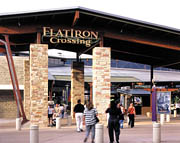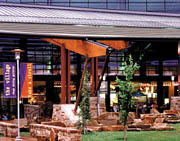

Contributing to the unique structure of the center is its outdoor surroundings. The shopping mall is comprised of two distinct park areas and FlatIron Crossing's Village -- a 240,000-square-foot streetscaped, outdoor, shopping space, which emulates the feel of the Rocky Mountains. To create this natural setting, over 2,000 tons of large-sized, rough-cut pieces of Masonville Buff sandstone were used in the design of water features and sitting areas, which are predominant throughout the outdoor portion of the shopping center.

Setting the stone
Landscape architect Bob Murase of Murase Associates, with offices in Portland, OR, and Seattle, WA, was on site with his son Scott, to oversee the installation of the stones. "We were working with three separate areas, which had very different components," said Murase. "It's very different from other malls. We wanted to make a place that was like a park. We also wanted to express the regional landscape in very artistic ways. The biggest feature was that we wanted to have a visual impact with water and stone."The sandstone, which was supplied by Masonville Quarry, was brought to the site in huge truckloads and loaded in a pile, the landscape architect explained. "We were on site every day to put the pieces together like a puzzle," he said. Murase further explained that it was important to balance the technical factors with aesthetic elements, when choosing the placement of the stones. "We had to consider the kind of mood we wanted to create with stone, and then how we wanted the water to interact with the stone," he said. "We wanted it to be that when you are there, it's magical. A place where water comes cascading out of stone features in a dynamic way."
To assist with implementing the design was a crew of three to eight workers from Tri-T Landscaping in Las Vegas. "We coordinated the purchasing of the stone up at the quarry and shipped it down to the site," said Project Manager Tracy Hoherz. "We shaped and trimmed the stone at the site, and then coordinated with Murase on placement." According to Hoherz, chisels were used to shape the pieces, while hammer drills were used to break the stone.
With pieces ranging in weight from 1/2 to 3 tons, the handling of the stone was difficult, said Hoherz. "We had to be careful with it," he said.
According to the project manager, the stones just sit on top of each other. Because each piece has been so carefully molded for its position, they just lock in place. For the pieces that are standing straight up, stainless steel bars were used to fastened the stone to the wall. In total, it took one month to complete this portion of the stone installation.

A new mall concept
The design plan that was implemented for FlatIron Crossing is among the latest concepts in retail design. It is considered to be a "hybrid" center -- a design combining a large, traditional enclosed mall with an urban streetscape retail/entertainment component. Deemed to be a prototype mall of the early 21st century -- both in North America and abroad -- FlatIron Crossing is among the first of its kind to be built in the U.S.Two objectives of this type of shopping center are to accommodate the time-pressed consumer, and to open the center to tenants that may not want or need the indoor mall experience. Additionally, it is intended to attract shoppers who may be bored with the typical mall format that has been around since the 1960s.
In the case of FlatIron Crossing, the design weaves together three primary influences -- a customer base whose affinity for the outdoors parallels sophisticated cultural tastes; a dramatic natural environment; and the agricultural heritage of the region, which is typified by "utilitarian structures of unpretentious forms and simple detailing," according to the design statement.
And it is because the design had such strong ties to the environment and heritage of the region that the architects of Callison Architecture, Inc. in Seattle, WA, chose Colorado's Lyons Red and Masonville Buff sandstone for the exterior and interior of the project. "We wanted to use a local stone," said Project Designer Dennis Rogers. "We looked at all of the different stones that were available in the region. This was the most common."
According to Rogers, the red and buff sandstones are used throughout the buildings on the campus of Colorado University at Boulder as well as throughout the city of Boulder. "We wanted to use the sandstone because it is used in that region, and also because of its local availability. The stone installers were very good at installing it."
The team at Callison devoted some time to studying the stonework on the college campus, Rogers explained. "We walked around the university and saw that they used a lot of different combinations of the red and buff," he said. "We tended to like the 90% buff and 10% red the best, and this mixture fit the building best. We did do some walls all red, but predominantly, the mixture was used."
Rogers explained that the stone was used in two different ways for FlatIron Crossing. For the building's walls throughout the exterior and interior, an ashlar pattern with a full-dimensional stone mortar set was employed. "The water features and landscape were actually quarried stone as they came off the rock faces," he said.
At the time they were working on the project, the architects came across a book written by Murase. "He does some very interesting work with rocks and stone," said Rogers. "He uses more natural types of landscaping instead of manicured -- when it is the right situation." After seeing Murase's book, the architects decided that he would be the right person to design the exterior areas of the shopping center.
"We were trying to capture the outdoor lifestyle of Colorado," said Rogers. "It was important to us to have these exterior places. It was actually Bob's idea to take the quarried stone knocked off the mountain. He wanted to create the feel of the Rocky Mountains with waterfalls and streams, but with more artistic interpretations."

A wide range of color
For the interior flooring, a Chinese quartzite was selected. "It had a very large range of color, and we liked that," said Rogers, adding that the material was also very affordable. "We wanted to create a ground plane inside. There is no banding or drops in the mall. It felt more natural for it to look like a ground plane."On the lower level, the shades of the quartzite range from very white to red. Rogers explained that there are 4- x 4-foot sections with random-sized stones filling the space.
For the floor on the second level, the color range was restricted to the lightest shades, according to the architect, who said that the quartzite was separated in China. The 8- x 16-inch pieces were laid in an ashlar pattern.
When considering materials for the floor, the architects had highs and lows to account for, according to Rogers. "The floor was more of a medium set," he said. "The quartzite had some variations, which gave the installers more tolerance to get the floor without clefting." The entire flooring took about six months to install.
FlatIron Crossing opened to the public on August 11, 2000. In addition to including a variety of specialty shops and four anchor department stores -- Nordstrom, Dillard's, Lord & Taylor and Foleys -- the shopping center also features several large restaurants and AMC Theaters. The mall will also be the first suburban shopping center in the U.S. to offer an off-road shuttle system.
Credit Box:
FlatIron CrossingDenver, CO
Developer: Westcor Partners, Phoenix, AZ
Architect: Callison Architecture, Inc., Seattle, WA
Landscape Architect: Murase Associates, Portland, OR, and Seattle, WA
Stone Supplier: Masonville Quarry, Masonville, CO (sandstone)
Stone Installers: Tri-T Landscaping, Las Vegas, NV; Yenter Co., Arvada, CO
General Contractor: Roche Constructors, Greeley, CO
